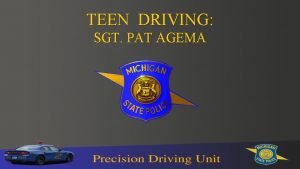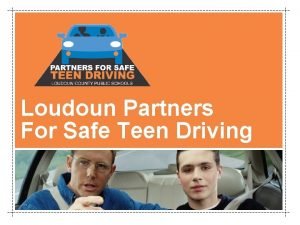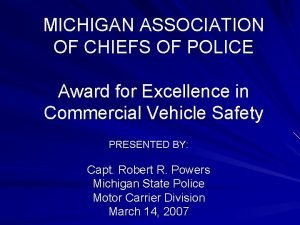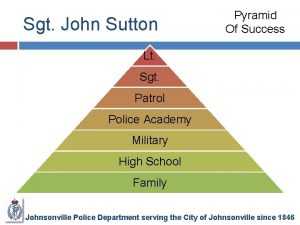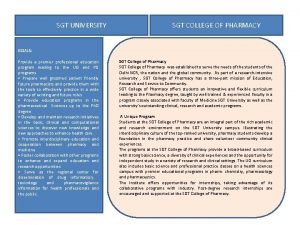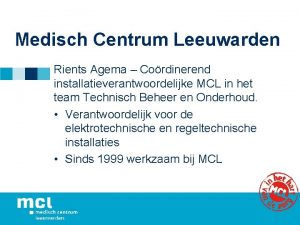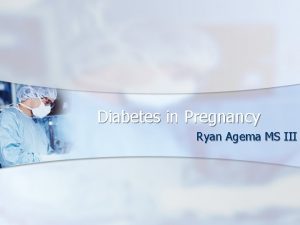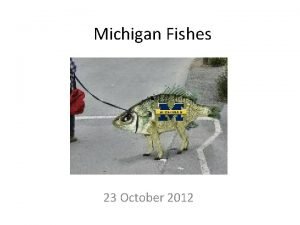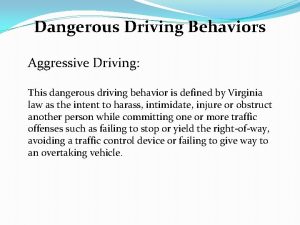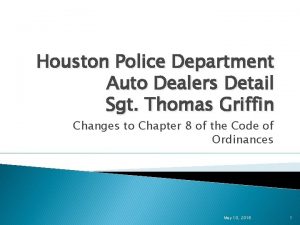TEEN DRIVING SGT PAT AGEMA Michigan State Police

































- Slides: 33

TEEN DRIVING: SGT. PAT AGEMA

Michigan State Police Precision Driving Unit

Sk id Track Facts Pa d Cone Pad § § § § 42 -Acre Site One-Mile Highway Response Course 9 -Acre Precision Maneuvering Pad 3 -Acre Skid Pad Off-Road Recovery Lane Classroom/Office/Observation Tower Five Full-Time Staff Members 44 Assigned Vehicles

OBJECTIVES: • What we teach and why. • Limited Practical experience is a DANGER

Consequences With Teen Drivers and Training • Drivers Education programs teach basic driving techniques • Don’t rely solely on a Drivers Education program to teach your child to drive • Competencies are based on Parents and Life experience. • Basic Vehicle Dynamics not being taught • Modern technology in todays vehicles

What we teach to Teen Drivers • • • The definition of Defensive Driving. The Lifestyle Theory of Driving The characteristics of a good driver. The Smith System of defensive driving. Basic driving skills which can reduce traffic collisions.

Skid Control: WHY?


SKID CONTROL LEFT TO CHANCE? ► The driver who is “caught off guard” by a skid and knows little or nothing about the forces involved, suffers panic and does nothing or reacts improperly ► Factors ► The influencing skid avoidance “Critical Link” in the control of your vehicle

► A skid can be defined as losing traction or “grip” with the roadway, by one or more of the vehicle’s tires. ► Effective skid control training will teach you to: ► Recognize the start of a skid ► Know what to do when the skid happens ► Know how to avoid a skid

DEFENSIVE DRIVING: WHY?

Defensive driving is the ability to operate your vehicle in such a manner as to be able to avoid involvement in a preventable accident no matter what the road and weather conditions

KEYS TO DEFENSIVE DRIVING: • When behind the wheel, make driving your FIRST priority • Anticipate a driver’s next move. Don’t be surprised by it.


DESTRACTED DRIVING: WHY?

DISTRACTED DRIVING • 3 Types of Distracted Driving – Visual (taking your eyes off the road) – Manual (taking your hands off the wheel) – Cognitive (taking your mind off what you are doing)


TEXTING WHILE DRIVING • Form of Distracted Driving – Texting while driving is 6 times more likely to result in a crash than driving while intoxicated. – 5 seconds is the minimal amount of attention a driver who texts takes away from the road. At 60 mph that’s 440’! – ILLEGAL IN MICHIGAN

HOW TO AVOID BEING DISTRACTED • Lessen the number of distractions in your vehicle. • Use bluetooth • Know where the controls are in your vehicle. • FOCUS ON THE TASK AT HAND: DRIVING

CRASH FACTS: • Motor vehicle crashes are the leading cause of death of Americans age 16 -24. • The comprehensive cost of crashes exceeds $830 billion annually. • 64 teens were killed in crashes in Michigan in 2017 • You are far more likely to die in a crash if you are not buckled up. • Males are twice as likely to be killed in a vehicle crash compared to females.

• One in Five 16 year old licensed drivers will become involved in a traffic crash • Nationally, Appx. 9 people are killed and 1000+ injured daily in crashes related to a distracted driver. • Handheld cell phone use is highest among 16 -24 year old drivers.

WHAT CAN WE DO TO REDUCE THESE STATISTICS? • Be patient behind the wheel • Be courteous to other drivers • Don’t text and drive – Activate Bluetooth and store your phone where you can’t reach it • Lead by example – Obey traffic laws – Your passengers are watching you


THE LIFE STYLE THEORY When behind the wheel, individuals are most likely to demonstrate the traits, behaviors or personality characteristics evident in nondriving time. (We drive as we live. )

CHARACTERISTICS OF A GOOD DRIVER The most important characteristic a driver can possess is MATURITY

Other qualities drivers need to possess are: • The ability to remain cool, calm, and collected in stressful driving situations. • An accurate perception of their driving abilities and the performance capabilities of their vehicle. • The ability to successfully apply their actual driving skills to specific situations in the driving environment. • Respect for other drivers


SMITH SYSTEM OF DRIVING

SMITH SYSTEM OF DEFENSIVE DRIVING Five point system established by Dr. Harold Smith in 1948.

T. U. G • Detecting everything on the front, on the sides, and to the rear of your vehicle. • Double checking intersections. • Watching out for pedestrians, especially children. • Watching other drivers to predict their next move.


CONCLUSION: • Adhere to the characteristics of a good driver. • Always wear your seat belt. • Remember be a good role model and set good examples • Don’t rely solely on a Drivers Education class to teach your TEEN.

THANK YOU: SGT. PAT AGEMA
 Michigan state police teenage defensive driving
Michigan state police teenage defensive driving Whitchester house
Whitchester house Ichat michigan
Ichat michigan Michigan state police ichat
Michigan state police ichat Pat pat seguimiento
Pat pat seguimiento Partners for safe teen driving
Partners for safe teen driving Michigan association of chiefs of police
Michigan association of chiefs of police The secret lives of sgt john wilson
The secret lives of sgt john wilson Teamfleet siemens
Teamfleet siemens Atty. agustin patricio
Atty. agustin patricio Sgt friday just the facts
Sgt friday just the facts Lt. leak lost battalion
Lt. leak lost battalion Sgt mosfet
Sgt mosfet Funcate sgt
Funcate sgt Rotary sergeant-at arms jokes
Rotary sergeant-at arms jokes Michigan state industries
Michigan state industries Pa state plane zones
Pa state plane zones Michigan raffle license application
Michigan raffle license application What is michigan's state song
What is michigan's state song State of michigan adoption subsidy
State of michigan adoption subsidy Msu physics and astronomy
Msu physics and astronomy Lms state of michigan
Lms state of michigan Department of treasury
Department of treasury Emphasis
Emphasis Latvian state police
Latvian state police Pa state police commercial vehicle safety division
Pa state police commercial vehicle safety division Indiana state police lab request form
Indiana state police lab request form Idaho state police forensics
Idaho state police forensics Virginia state police firearms transaction center
Virginia state police firearms transaction center Delaware information and analysis center
Delaware information and analysis center Nazi police state lesson
Nazi police state lesson The nazi police state
The nazi police state Louisiana state police tier ii reporting
Louisiana state police tier ii reporting Driving age by state
Driving age by state
